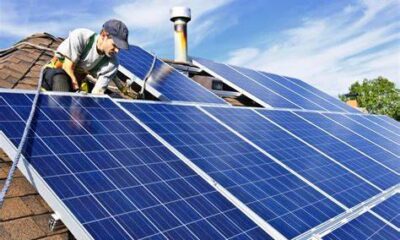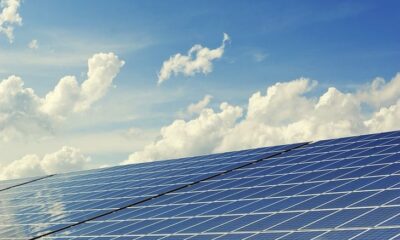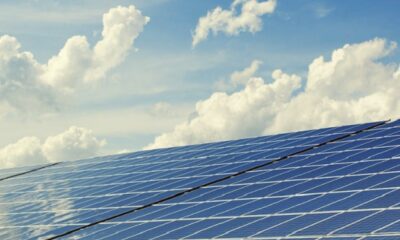Tech
How Do Flexible Solar Panels Work

Solar energy has become an increasingly popular renewable energy source in recent years. With the advancement of technology, solar panels have become more efficient and cost-effective, making them more accessible to the general public. In addition to traditional rigid solar panels, there are now flexible solar panels available on the market. But how do these flexible panels work?
In this blog post, we will explore the inner workings of flexible solar panels, including the materials they are made of, how they generate electricity, and their benefits and drawbacks compared to traditional solar panels. Whether you are considering installing solar panels on your home or simply curious about the latest solar technology, this post will provide valuable insight into the world of flexible solar panels.
Flexible solar panels are a type of solar panel that is designed to be flexible and bendable, unlike traditional rigid solar panels. They are also commonly referred to as thin-film solar panels or flexible solar modules.
Flexible solar panels are made from materials that are lightweight and thin, such as thin-film solar cells or polymer materials. This makes them easier to install and transport than traditional solar panels, which can be heavy and bulky. They are also more versatile in terms of installation, as they can be installed on curved or irregular surfaces, such as on boats, RVs, or backpacks.
While flexible solar panels may not be as efficient as traditional solar panels, they can still generate significant amounts of electricity from sunlight. They are often used in applications where traditional solar panels are not practical, such as in portable solar chargers, remote power systems, and other off-grid applications.
Flexible solar panels work on the same basic principles as traditional solar panels, but they are constructed with different materials that allow them to bend and flex. The inner workings of flexible solar panels include:
Photovoltaic cells: These are the cells that convert sunlight into electricity. Flexible solar panels, these cells are made from materials that can bend and flex, such as thin film or polymer materials.
Encapsulation layers: To protect the photovoltaic cells, flexible solar panels are often encapsulated with layers of materials such as plastic or glass. These layers also help to maintain the structural integrity of the panel.
Conductive materials: To transfer the electricity generated by the photovoltaic cells, flexible solar panels use conductive materials such as copper or aluminum wires.
Backing material: The backing material of flexible solar panels is typically made from a flexible polymer material. This material provides support for the panel while also allowing it to bend and flex.
Overall, the inner workings of flexible solar panels involve materials and components that are designed to allow the panel to bend and flex while still generating electricity from sunlight.
What materials solar panels are made of?
Solar panels are made of several different materials, each with its own unique properties and functions. The most important component of a solar panel is the photovoltaic (PV) cells, which are responsible for converting sunlight into electricity. PV cells are typically made of silicon, a common and abundant element found in sand. Silicon is chosen for its ability to convert sunlight into electricity with a high degree of efficiency.
In addition to PV cells, solar panels are also made up of several other materials. The frame of a solar panel is typically made of aluminum, which is lightweight and strong, providing support for the PV cells. The back sheet, which protects the board from moisture and other environmental factors, is often made of a polymer material such as Tedlar.
How do solar panels generate electricity?
Solar panels generate electricity through the use of photovoltaic (PV) cells. PV cells are made of silicon and other materials that can convert sunlight into direct current (DC) electricity. When sunlight hits the surface of the PV cells, it excites the electrons within the cells, causing them to flow in a particular direction, which creates an electric current.
The electric current produced by the PV cells is in the form of DC electricity, which is not suitable for most household and commercial applications. Therefore, the electricity must be converted into alternating current (AC) electricity using an inverter. The inverter takes the DC electricity produced by the solar panels and converts it into AC electricity, which can be used to power homes, businesses, and other electrical devices.
Once the electricity has been converted to AC, it can be used immediately or stored in batteries for later use. In some cases, excess electricity generated by the solar panels can be fed back into the grid for credit, allowing the owner of the solar panels to offset their electricity costs.
Merits and Demerits of solar panels compared to traditional solar panels
Flexible solar panels offer several benefits and drawbacks compared to traditional rigid solar panels. One of the main benefits of flexible solar panels is their versatility. Because they are flexible, they can be installed on a variety of surfaces, including curved surfaces and surfaces that are not typically suitable for traditional solar panels. This makes them ideal for use on boats, RVs, and other vehicles, as well as on buildings with unconventional or curved roof lines.
Another benefit of flexible solar panels is their durability. Traditional solar panels are made of glass, which can be fragile and prone to cracking or breaking. Flexible solar panels, on the other hand, are typically made of a polymer material that is much more durable and resistant to damage from impacts, weather, and other environmental factors.
However, there are also some drawbacks to flexible solar panels. One of the main drawbacks is their efficiency. Flexible solar panels tend to have lower efficiency ratings than traditional solar panels, which means they produce less electricity for the same amount of sunlight. This can make them less practical for use in situations where space is limited, or where maximum power output is required.
Another drawback of flexible solar panels is their cost. Because they are a newer technology and require more advanced manufacturing techniques, they are typically more expensive than traditional solar panels. However, the cost of flexible solar panels is expected to come down over time as the technology becomes more widespread and manufacturing processes become more efficient.
In summary, flexible solar panels offer several benefits compared to traditional solar panels, including their versatility and durability. However, they also have some drawbacks, including lower efficiency ratings and higher costs. When deciding which type of solar panel to use, it’s important to consider your specific needs and circumstances to determine which type will be the best fit for you.
-
Blog1 year ago
MyCSULB: Login to CSULB Student and Employee Portal – MyCSULB 2023
-
Android App3 years ago
Cqatest App What is It
-
Android1 year ago
What Is content://com.android.browser.home/ All About in 2023? Set Up content com android browser home
-
Software2 years ago
A Guide For Better Cybersecurity & Data Protection For Your Devices
-
Latest News2 years ago
Soap2day Similar Sites And Alternatives To Watch Free Movies
-
Android2 years ago
What is OMACP And How To Remove It? Easy Guide OMACP 2022
-
Android3 years ago
What is org.codeaurora.snapcam?
-
Business2 years ago
Know Your Business (KYB) Process – Critical Component For Partnerships



























